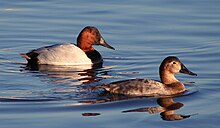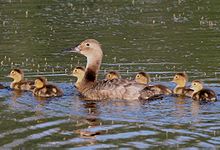Giant pochard
| Giant pochard | ||||||||||||
|---|---|---|---|---|---|---|---|---|---|---|---|---|

Giant pochard - male - |
||||||||||||
| Systematics | ||||||||||||
|
||||||||||||
| Scientific name | ||||||||||||
| Aythya valisineria | ||||||||||||
| ( Wilson , 1814) |
The giant pochard ( Aythya valisineria ) is a North American diving duck and is also called Vallisneriaente . It is similar in its spring dress Rotkopf- and Pochard . It is the largest species among diving ducks.
The populations of the giant pochard decreased by 0.6 percent annually between 1955 and 1993. In 1996, however, there was a very strong increase. For this year the population was estimated at 770,600 individuals. In the 1980s, the population averaged 510,000 individuals. The reasons for these population fluctuations have not yet been sufficiently scientifically investigated. Habitat losses, a low mating rate and high mortality during the first year of life contribute to the population decline. The sudden increase in the 1990s may be related to significantly improved water quality at important rest areas.
Giant tabby ducks are occasionally seen in Central Europe. The majority of these are prisoner refugees . On the other hand, a male is considered a wild bird that was observed in the Netherlands from January to March 2003.
features
The 48 to 60 cm long and up to 1270 g heavy pochard has a pronounced sexual dimorphism . While the male is colored rust-red on the head and neck, light gray on the flanks and black on the burst and rump , the gray-speckled female is colored brown on the head, neck and rump.
Their head profile is striking: the beak ridge starts very high on the forehead so that the head looks almost wedge-shaped when viewed from the side. It can be distinguished from the red headed duck mainly on the basis of this head profile.
distribution
The giant pochard breeds from Alaska to Nebraska and Minnesota and overwinters from British Columbia , the Great Lakes region and Massachusetts to south to Florida , Texas and Mexico . The bird lives on lakes, rivers, inlets and bays.
Migrating giant table ducks occasionally also reach Europe on their train. As a rare random visitor , they are recorded on Iceland, Great Britain, Germany, Hawaii and the Marshall Islands.
behavior
The giant pochard dips most of its food, which mainly consists of aquatic plants, but also molluscs, aquatic insects and small fish. Its predilection for the so-called "wild celery" Vallisneria americana gave the species its scientific name. In autumn, this plant makes up up to 43 percent of their diet. As with many other duck species, however, the availability is crucial for the composition of the food. At some rest areas during the train, giant paddock eat almost exclusively animal food. This can be due to a reduced food supply at the rest areas. The eating habits of the giant pochard that overwinter in Chesapeake Bay changed from a predominantly vegetable diet to one that consists almost exclusively of invertebrates and small fish. At the same time as this change in diet, the underwater vegetation in the Chesapeake Bay declined significantly. The number of giant tabby ducks in this North American bay also fell; instead, a larger number of giant tabernacles overwintered in the brackish water on the North Carolina coast.
The giant pochard is often associated with red-headed and violet ducks. She spends most of the day sleeping or resting on open water. She seeks her feeding places at the shallow water spots in the morning and in the evening. Most of their foraging takes place while diving. It regularly reaches water depths of up to four meters. Due to its size, it can dive deeper than other diving ducks. However, it can also be seen basking in shallower waters.
Reproduction
The giant pochard looks for a new partner every year and mates in late winter. It often nests in small inland waterways between reeds and similar plants on the ground or on a floating raft made of plant material near the shore. Giant table ducks are not territorial ducks. The nests of this species are often close together. Around 10 eggs are incubated by the female for 24-29 days. The male stays near the female until the start of breeding and then moves to the moulting sites. The well-developed young can follow their mother into the water to search for food soon after hatching, but only fledged after 56 to 77 days.
The red headed duck is a brood parasite of the giant pochard. Most of the giant pochard's nests contain at least one egg of this species.
supporting documents
literature
- Janet Kear (Ed.): Ducks, Geese and Swans. Oxford University Press, 2005, ISBN 0198546459 .
- Hartmut Kolbe; Die Entenvögel der Welt , Ulmer Verlag 1999, ISBN 3-8001-7442-1
- John Gooders and Trevor Boyer: Ducks of Britain and the Northern Hemisphere , Dragon's World Ltd, Surrey 1986, ISBN 1-85028-022-3
Individual evidence
- ↑ Kear, p. 640
- ↑ Kear, p. 643
- ↑ Hans-Günther Bauer, Einhard Bezzel and Wolfgang Fiedler (eds.): The compendium of birds in Central Europe: Everything about biology, endangerment and protection. Volume 1: Nonpasseriformes - non-sparrow birds , Aula-Verlag Wiebelsheim, Wiesbaden 2005, ISBN 3-89104-647-2 , p. 114
- ↑ Kear, p. 640
- ↑ Kear, p. 641
- ^ Kear, p. 641 and p. 642
- ↑ Gooders and Boyer, p. 82
- ↑ Gooders and Boyer, p. 82
- ↑ Gooders and Boyer, p. 82
Web links
- Aythya valisineria in the endangered Red List species the IUCN 2008. Posted by: BirdLife International, 2008. Accessed January 31 of 2009.
- Videos, photos and sound recordings for Aythya valisineria in the Internet Bird Collection


